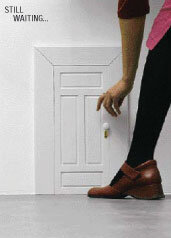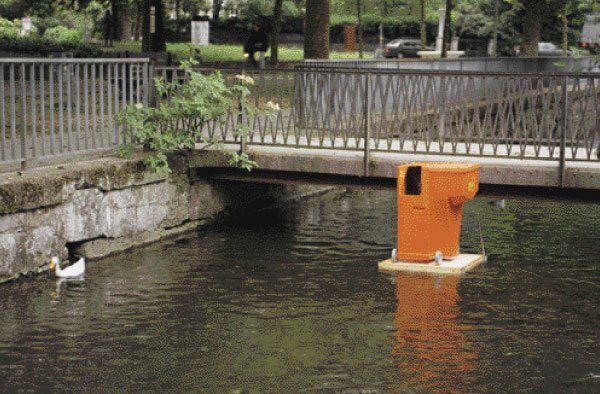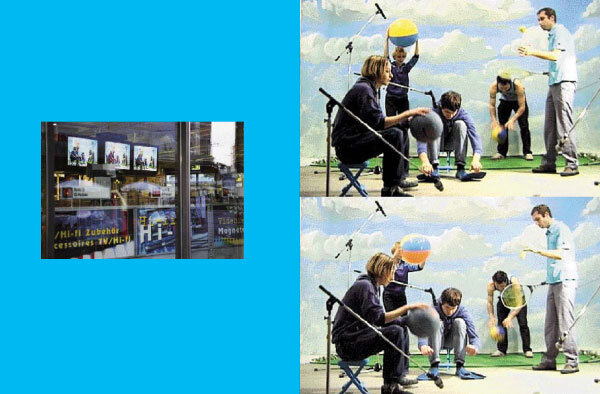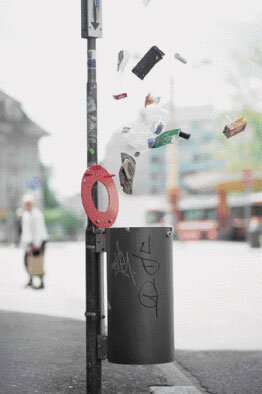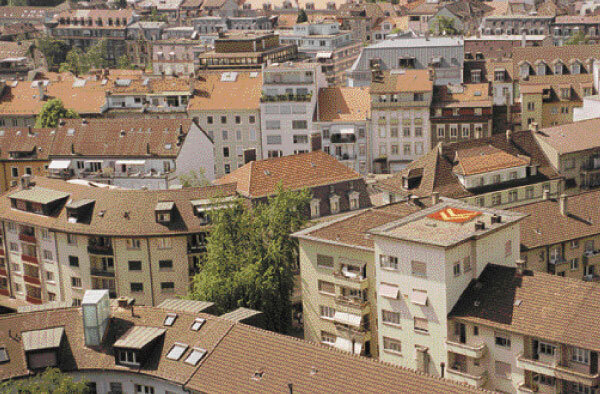TRANSFERT Art in urban space
Joshua Decter
JOSHUA DECTER
COMMUNICATION CITY
On the level of metaphor, every person is a city, just as every city is fundamentally a composite – an abstract and material embodiment – of its population in relation to specific codes & systems of inhabitation. There are significant differences between urban territories around the globe (as any tourist will remind you), particularly in the comparison between developing countries and late capitalist nations, and certainly it is untenable to put forth a singular, universalizing definition of the city. Every city – regardless of its global location and/or sociopolitical situation – is a multidimensional complex of invariably paradoxical elements, wherein heterogeneity and homogeneity coexist in a continuous state of tension. Cities have the capacity to incorporate everything into their dense fabrics; cities are at once sponges of social interchange and triggers for every possible type of transformation. Interlaced rhythms of stasis and motion are characteristics of every urban context. The city is an amalgam of public space, private space, the social, the anti-social, politics, religion, culture, health, sickness, wealth, poverty, law, criminality, sex, abstinence, birth, death, dirt, electricity, communication systems, fauna, flora, transportation systems (both private and public forms), diverse architectures, and much, much more.
Philosopher Henri Lefebvre understands the city to be an arena for the “encounter between differences,” a space which both produces social relations and is produced by social relations. Lefebvre suggests that we tend to think about the contemporary urban environment in contradictory terms: as both an abstract space modeled upon hierarchical orderings (e.g., center, periphery) that may reinforce dominant economic relations, and as a space of ruptures, disjunctions, flux, and “pulverizations” (Lefebvre’s term). Against the will to homogenize urban space (and therefore urban experience) according to the logic of advanced capitalism, social subjects – i.e., individuals – attempt to articulate distinct uses of that space, employing imagination as a device to re-invent their negotiations of urban order.
“Moving elements in a city, and in particular the people and their activities, are as important as the stationary physical parts. We are not simply observers of this spectacle, but are ourselves a part of it, on the stage with other participants. Most often our perception of the city is not sustained, but rather partial, fragmentary, mixed with other concerns. Nearly every sense is in operation, and the image is the composite of them all.” 1
To a certain extent, the development of the genre of the urban/city-based art exhibition during the latter half of the 20th Century is related to a broader issue. Namely, the effort to open up the relative autonomy of vanguard art, to re-distribute the practice, language and ideologies of artmaking back into the fabric of so-called “everyday life.” Taking art out of the specialized containers for art – i.e., the studio, the gallery, the museum, the private collection – and returning it to the so-called ordinary precincts of life: e.g., the street, the home, etc. In other words, redelivering art back to non-specialized domains, while also creating the possibility of reinventing the relationship between culture and public. In one sense, this reflects a more recent (i.e., late 20th Century) preoccupation with re-injecting the insulated activity of the modernist art world back into the “mainstream” of cultural activity.
With the emergence of industrialized urban centers in Europe during the mid- and late 19th Century, and the attendant bourgeois self-consciousness of belonging to a new model of social organization (articulated with vivid, poetic resonance in the writings of Baudelaire, and later in Breton’s metaphoric meanderings through Paris, and still later with Debord’s Situationist writings), the stage is set for the notion of the city as a context for the unfolding of aesthetic experience which becomes a defining – if not paradigmatic – conceit of the 20th Century. The city as muse, in a sense, displacing the function of nature. A new urban sublime, exemplified by those artists, poets, and architects and other cultural producers who used the social energy of the city as fuel for experimentation and innovation.
How else can we account for the early collages of Picasso, who incorporated fragments of newspapers into the semiotic and material texture of his art language, thereby denoting a primary “everyday” system of mass communication within the urban framework? Or, recall the invocations of a new modern experience revealed in certain works of the Italian Futurists, who not only marveled at the new dynamics of modern industrialization, yet more significantly endeavored to visually invoke the simultaneity of urban social space ushered in during the initial decades of the 20th century. And, let’s not forget Léger’s visions of the relation between labor, building and industrialization. And, perhaps most significantly, the activities of the Dadaists often took into strategic account the utilization of urban space as a staging platform for material & symbolic revolts against the apparent homogeneity of bourgeois life and values - and the corresponding alienation of avant-garde art from the broader social-cultural context. However, if we refer to this history, it then becomes necessary to address a recurrent cultural paradox. For instance, regarding the implications of Dadaism, we should recognize that every anarchic attempt to explode and subvert artistic conventions was, perhaps unconsciously, also an effort to reintegrate art back into the social & political – i.e., re-endowing art with an instrumental function (yet under the guise of the non-instrumental). The negation of art in order to invent another set of cultural relations, perhaps.
In a controversial, widely-debated text from the early 1980s, Modernity : An Incomplete Project, Jürgen Habermas reflected upon another aspect of this paradox. Habermas suggested that the Surrealist revolt against post-Enlightenment rationalization, and the division between art and life (i.e., the attempt to seek conceptual/symbolic reconciliation between art object and utilitarian object, between aesthetic judgments and everyday cognition), served, ironically, to reinforce the autonomy of the aesthetic sphere. Habermas argued that even the most radical attacks on the bourgeois autonomy of art (by artists and other art specialists) only functioned to momentarily splinter the contents of one autonomous cultural sphere (i.e., the sphere of visual art culture). As a result, the autonomy of art was actually reinforced, since attacks upon a specific cultural sphere (avant-garde art) could not have a transformative – i.e., de-sublimating – effect upon a rationalized society wherein there was no communication between distinct realms of specialization. If one endorses the type of argument proposed by Habermas, it might be possible to analyze how the relatively autonomous-specialized sphere of the art world continuously recuperates even its most radical social, political, conceptual or aesthetic gestures as conventions or as genres.
We have witnessed the almost inevitable process by which various “radical” art languages, innovative exhibition frameworks and daring curatorial strategies are recuperated as – or into – a set of familiar conventions and genres. This, perhaps, is the logical outgrowth of the historical and ideological characteristics of vanguardism, wherein “newness” is invariably institutionalized, reified. We have become accustomed to the continuous oscillation of expansion and contraction, progression and retrogression. Or, to use an American expression: “one step forward, two steps back”. Every time we seek to expand the language and/or context of artmaking to the point of no return (i.e., the collapse of art and of “the real”), we return to the ineluctable truth that art is not the same thing as “everyday” reality. Art constitutes its own reality, does it not? And each time that we seek to re-inject or diffuse the relative autonomy of art into the territory of the everyday, we are confronted with the fact of a fundamental incompatibility (at the level of meaning). This serves to amplify the distinction between art and everything else – even if we accept the premise that art is merely a part of everything else that is not art. Over the past fifty years (perhaps longer), this sort of philosophical dilemma – the fundamental dilemma of the avant-garde – has triggered a degree of frustration amongst certain artists, theorists, and curators, leading to the investigation of alternative territories for the creation of art. Fluxus, both the American and European variations, reflected this spirit of producing art that would resist historical institutionalization due to its ephemeral, event-oriented characteristics. Paradoxically, of course, Fluxus exists today only in archival form, dependent upon the traditional systems of the museum and art history. We can detect aspects of the post-Fluxus spirit in the work of a younger generation of artists who emerged in the 1990s, and have re-considered the model of artmaking as social activity/event. To an extent, this has led certain artists to reconsider elements of urban space that are deemed to be peripheral to the institutional precincts of the art world. The problem, at least on theoretical terms, is that once an art activity unfolds in a non-traditional urban context, that context becomes temporarily redefined as an extension of the art system. This effect is complicated, interesting, and troubling.
The issue of expanding the language and sites of artmaking has been the preoccupation of a range of “post-studio” Conceptualists who emerged in the late 1960s and early 1970s. For example, Douglas Huebler, Dennis Oppenheim, Lawrence Weiner, Daniel Buren, Robert Smithson, Michael Heizer and Alice Aycock, as well as the seminal urban-based interventions of Gordon Matta-Clark. In regard to Smithson, it is important to recall that his practice always took into account the subtle interplay between Site and Non-Site, between a remote location in nature and the context of the art gallery. Smithson revealed to us that there really is no “outside” territory beyond the art system – rather, a series of dialogical interrelations that can be articulated between distinct contexts. Somewhat later, artists such as Michael Asher and Hans Haacke returned to the site of cultural authority – the museum – to conduct critical infiltrations & deconstructions of institutional power. Such strategies eventually became a genre of “institutional critique,” articulated by artists such as Louise Lawler, Mark Dion, Christian Phillip-Muller, and Andrea Fraser. Ironically (or not so ironically), institutional critique became institutionalized itself – which was an inevitable development, since tactics of critical infiltration always require a certain degree of complicity with the authority of the museum. A kind of tautological collapse was precipitated by such paradoxes and double-binds, and then it became necessary to operate “outside” of the system.
But where is this putative “outside” actually located? Within the differentiated/non-differentiated space of the city ? Maybe, maybe not. But there has always been a desire (or fantasy) to locate a space of cultural production that is not encumbered or burdened by the art system – itself, a paradoxical desire. Today, with the emergence of a fully globalized art world of interconnected urban centers, this desire is often expressed in relation to the space of the city. In a sense, this has been an effort to re-colonize public city-space as a platform for specialized artmaking activities, so that artists are given an opportunity to respond directly to all aspects of the everyday urban environment. The city as a cultural laboratory? The city as an adjusted readymade?
Commencing in the early 1970s within the U.S., various genres of Public Art and Site Specific Art began to emerge, ranging from highly political, grassroots forms of oppositional practice, to much tamer varieties of the corporate commissions – and just about everything in between. Private foundations and cultural organizations (as well as state & local government agencies) were soon developed to provide a commissioning structure for artists who sought to produce work beyond the precincts of the studio, gallery, and museum. In New York, for example, we have small organizations such as Creative Time and The Public Art Fund, which both function to sponsor & commission individual artists working in the public/urban realm. Even so, relatively few individual artist projects are actually implemented. Unlike Europe, in the U.S. there just isn’t a developed history of municipal support for urban-based exhibitions, and so there is very little funding to support these endeavors, nor sufficient commitment from the art world here. Of course, there have been a few exceptions: e.g., Mary Jane Jacob’s well-known Culture in Action/Sculpture Chicago from 1993, the smaller-scale (and lesser known) New York-based Architectures of Display in 1995 (featuring collaborations between artists and architects on projects for shops and other businesses in the Soho area of Manhattan), and inSITE97 (featuring context-specific projects by artists addressing the border zone between San Diego and Tijuana). But Americans do not really have a tradition linking vanguard, site-specific artmaking to civic/public space. One could argue, I think persuasively, that the utilization of the city-space as an environment for the development of art exhibitions has also been an effort, fundamentally, to expand and rethink the interrelationship between art production and the broader cultural-social realm. This is a symbolic (and, to an extent, material) re-production of the city-space for purposes of specialized cultural activities: i.e., activities which do not fall readily into categories of advertising, commerce, business, popular culture, tourism and related applications. Yet we also understand that the utilization of city-space as the framework of a group exhibition is related to developing new opportunities for the interconnection between site-specific artmaking and “cultural tourism.” Prominent examples include the most recent Istanbul Biennal (wherein the exhibition was dispersed into various nodes of the city), as well as the ongoing Munster Sculpture Project (which has always utilized the city as a neutral backdrop).
Fundamentally, the city-space exhibition should endeavor to reinvent relationships between production and reception, between art and audience, between consumer and producer. In addition, the development of exhibitions that are interdependent upon the architectural spaces and infrastructures of a city articulates a desire to introduce a new model of curatorial activity that will, in turn, suggest new possibilities for artmaking. In other words, an urban-based curatorial framework invariably seeks to compel artists to rethink the conventions of their own respective practices in relation to the multiple material and imaginary trajectories of the city. Yet, a number of important questions persist: is anything really reinvented in these circumstances? Or, does the city-based exhibition merely provide an expanded institutional venue for the artist: i.e., the unfolding and/or splintering of the site of the museum into an array of distinct urban spaces? If the environment of the city is utilized as the widest, most inclusive, stage for artmaking, does this transform the fundamental relationship between artist, artwork, and the public? And who will respond to these questions? If one is to produce exhibitions for city-spaces, there should be an opportunity for these questions to be publicly discussed by all those who inhabit that particular urban environment – not only art specialists, but people from all types of professions, economic backgrounds, cultural & ethnic affiliations, tastes, desires and ideological proclivities. An open, inclusive public discourse regarding the function and meaning of urban-based exhibitions will serve, hopefully, to precipitate new lines of communication across the symbolic and actual boundaries of disciplinary specialization.
Beyond the concrete territory of the actual city, the Internet and the web are being utilized to explore new types of virtual urban and meta-urban environments, facilitated by interactive modes of communication. The interrelationship between the off-line world of the city and the on-line world of the web is now one of the most important areas of exploration, requiring us to re-think traditional modes of organizing our locations and identities in relation to the body, the community, the city, the nation, time & space, and the globe. We live in a post-Euclidean world wherein older types of mapmaking are no longer entirely reliable, wherein distinctions – on the level of both theory, and lived experience – are increasingly difficult to maintain between the material off-line world and the immaterial on-line world. Each time we enter the Internet, and build things on the web, we are at once located in a rational spatio-temporal dimension (at the computer terminal), yet simultaneously delivered into an ephemeral arena of continuous flows that resists classical explanation. If I live in a city, and I am plugged-into the Internet, I am located and dislocated, plugged-out, somewhere and nowhere – all at the same time. Of course, it is paradoxical. I am in a constant state of being “in between” locations. On a cognitive level, I am flowing through all urban centers, suburban extensions, rural towns, and various other intermediary, transnational, global territories.
In a sense, the actual space of the city is being dispersed into the virtual terrain of the web, and vice-versa. The web can be theorized as a composite of multiple theoretical cities, organized according to the new interlaced dynamics of community and communication. And, with the advent of new “wireless web” technology, the mobile phone is becoming a portable Internet device that will facilitate all modes of on-line interface. Everything is being connected to everything else. So, the question is no longer where you are physically located, but rather, whether (and how) you are connected. Invoking the visionary work of the British group Archigram, our cities are not only plugged-in, but urban centers have also become constellations of people-driven wireless interfaces. Actual cities (and suburban environs) may still be the locus of commerce, culture and information, yet the web has become a free-floating nexus between all virtual cities, towns, businesses, institutions, and individuals. In other words, cities are now “plugged-out,” facilitating new interchanges (on symbolic and literal levels) with suburban and rural territories. It is not only an issue of what unfolds within the actual space of a particular city, but more significantly, how that local environment interacts with a multiplicity of other local environments around the globe via the Internet and web.
“(…) Urban public space is not merely un-private – what’s left over when everyone walls off their private domains. A space is genuinely public, as Kevin Lynch once pointed out, only to the extent that it really is openly accessible and welcoming to members of the community that it serves. It must also allow users considerable freedom of assembly and action. And there must be some kind of public control of its use and its transformation over time. The same goes for public cyberspace, so creators and maintainers of public, semipublic, and pseudopublic parts of the online world – like the makers of city squares, public parks, office building lobbies, shopping mall atriums, and Disneyland Main Streets – must consider who gets in and who gets excluded, what can and cannot be done there, whose norms are enforced, and who exerts control.”2
Indeed: how is control exerted over real and virtual city-spaces? Who determines inclusion and exclusion? Today, we construct ourselves in relation to both tangible space and cyberspace, and the implementation of all urban-based art exhibitions must take this evolution into account.
1 Kevin Lynch, The Image of the City, MIT Press, Cambridge, London, 1960.
2 William J. Mitchell, City of Bits, MIT Press, Cambridge, London, 1996.


